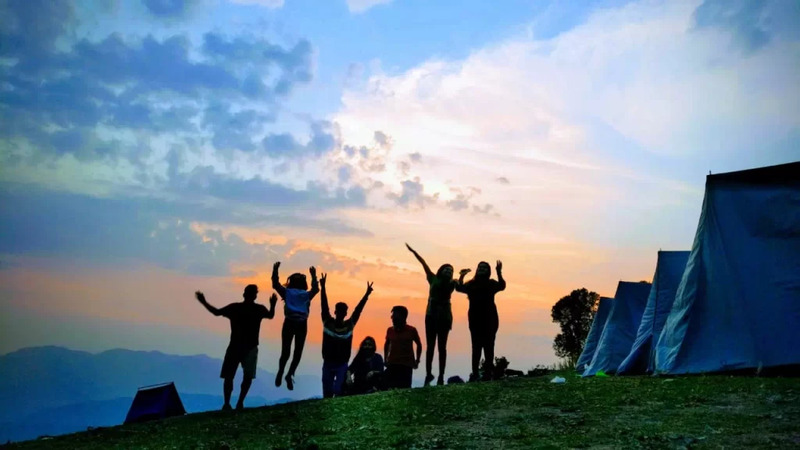Navigating the Trail: Solo vs. Group Trekking - A Detailed Exploration of Pros and Cons
Embarking on a trek is a profound journey that extends beyond the physical act of traversing landscapes. One of the fundamental decisions trekkers face is whether to venture solo or join a group. Each approach comes with its own set of advantages and challenges, shaping the nature of the trekking experience. In this exploration, we'll delve into the pros and cons of solo and group trekking, offering insights to help you make an informed decision and tailor your journey to align with your preferences and aspirations.
Solo Trekking:

Pros:
- Freedom and Flexibility: The allure of solo trekking lies in the absolute freedom it offers. You dictate the pace, choose the route, and decide when to rest or press forward. This autonomy allows for a deeply personal and introspective experience.
- Self-Discovery and Reflection: Solo treks often provide a unique space for self-discovery and introspection. With solitude as your companion, you have the opportunity to delve into your thoughts, challenge personal limits, and forge a deep connection with nature.
- Tailored Itinerary: Your trek, your rules. Solo trekkers can create a customised itinerary based on personal preferences. Whether it's tackling challenging ascents, exploring off-the-beaten paths, or simply relishing moments of quietude, the journey unfolds according to individual desires.
- Increased Wilderness Experience: Solo trekkers are more likely to immerse themselves in the wilderness. The absence of group dynamics enables a heightened connection with the natural surroundings, offering a more authentic experience of the landscapes traversed.
- Flexibility in Decision-Making: Decisions are swift and personal in solo trekking. From choosing a campsite to altering the route based on individual preferences, solo trekkers enjoy the flexibility of adapting to changing circumstances on the fly.
Cons:
- Safety Concerns: One of the primary drawbacks of solo trekking is the increased vulnerability to unforeseen challenges. Safety concerns, ranging from medical emergencies to navigation difficulties, can be more daunting without the support and shared responsibilities of a group.
- Loneliness and Isolation: The solitude that brings self-reflection can also lead to feelings of loneliness. The absence of companionship might impact the overall enjoyment of the trek, especially during long stretches of isolation.
- Logistical Challenges: Planning and executing a solo trek demand meticulous organisation. From transportation to permits and accommodations, every detail falls on the shoulders of the solo trekker, requiring a higher level of logistical prowess.
- Limited Shared Experiences: Solo trekkers miss out on the shared camaraderie and collective experiences that come with group dynamics. The joy of celebrating achievements and overcoming challenges becomes a more solitary affair.
- Higher Responsibility for Emergency Situations: In the event of an emergency, a solo trekker must rely solely on their own skills and resources. The responsibility for quick decision-making and problem-solving rests squarely on their shoulders.
Group Trekking:
Pros:

- Safety in Numbers: The adage "safety in numbers" holds true for group trekking. Facing challenges such as adverse weather, medical emergencies, or navigation issues becomes more manageable with the collective expertise and support of the group.
- Shared Responsibilities: Group treks distribute responsibilities among members, fostering a sense of community and shared commitment. Tasks like setting up camp, navigation, and cooking are divided, alleviating individual burdens.
- Social Interaction and Camaraderie: Group treks offer an enriching social experience. The shared challenges and triumphs create lasting bonds among participants, making the journey as much about the people as the landscapes.
- Expert Guidance: Joining a group trek often means having access to the expertise of guides and experienced trekkers. This can enhance the overall trekking experience, providing valuable insights into local culture, geography, and safety precautions.
- Collaborative Decision-Making: Group dynamics encourage collaborative decision-making. From selecting the route to deciding the pace and resting points, group members contribute to the overall planning, creating a more inclusive trekking experience.
Cons:
- Limited Autonomy: The collective decision-making process may limit the autonomy of individual trekkers. Group consensus often shapes the itinerary and pace, potentially restricting the freedom to explore personal interests.
- Potential for Conflicts: Group dynamics can lead to conflicts, ranging from disagreements on the route to differences in trekking preferences. Resolving such conflicts requires effective communication and compromise among group members.
- Less Intimate Wilderness Experience: The presence of a group can dilute the intimacy of the wilderness experience. The need for coordination and consideration for group members may divert attention from personal reflections and connections with nature.
- Dependency on Group Support: While safety is a collective benefit, dependency on group support may hinder individual problem-solving skills. The reliance on the group for decision-making and navigation can lead to a diminished sense of self-reliance.
- Varied Skill Levels: Groups may consist of individuals with varying trekking experience and physical fitness levels. Managing these differences can be a challenge, with the potential for slower progress or disparities in trekking capabilities.
Conclusion: Finding Your Trekking Style: The choice between solo and group trekking ultimately depends on individual preferences, priorities, and the desired nature of the trekking experience. Solo trekking appeals to those seeking independence, self-discovery, and the freedom to chart their own course. It demands a higher level of preparation, self-sufficiency, and a keen awareness of potential risks.
On the other hand, group trekking offers a shared adventure, safety in companionship, and a supportive network of fellow trekkers. It is an ideal choice for those who appreciate shared responsibilities, camaraderie, and the opportunity to learn from the experiences of others.
In the end, the magic of trekking lies in the diverse array of experiences it offers, regardless of the chosen approach. Whether you find solace in solo reflections or joy in shared laughter around a campfire, the trail beckons with lessons, challenges, and the untamed beauty of the great outdoors. As you lace up your hiking boots, consider the pros and cons, but remember that the most significant journey is the one that aligns with your heart and soul. Happy trekking!


